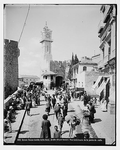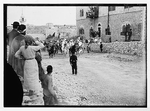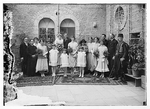The American Colony and the Matson Photo Service |
The American Colony, 1881-1934
The American Colony was an independent, utopian, Christian sect formed by religious pilgrims who emigrated to Jerusalem from the United States and Sweden. The history of the Colony is intimately linked to the photography collection it spawned.
Founding of the Colony
The initial wave of immigrants came to Jerusalem in 1881 from Chicago, Illinois. The "Overcomers," as this group called itself, were followers of the charismatic Horatio Gates Spafford, formerly a lawyer and businessman, and his Norwegian-born, but American raised wife, Anna. A second wave of American immigrants joined the Overcomers in 1896. Olof Henrik Larson, an evangelical Swede who had relocated to America and settled in Chicago, was their leader. He also inspired a sister group from Nås parish in Dalarna, Sweden, which arrived later the same year.
 Jaffa Gate LC-DIG-matpc-06546 The American Colony's store, which was originally called "Fr. Vester & Co.," and was later renamed the "American Colony Stores," can be seen can be seen on the right in this photograph. |
Colony Philosophy and Activities
These Christians shared a belief in the Second Coming of Christ at the Millennium. The colony of about one hundred people at first lived communally. Devoting themselves to the people of Jerusalem--regardless of religion or nationality–they cared for the sick and set up schools and soup kitchens, among other endeavors. They hoped to ensure their redemption through their charitable work.
After the turn of the century, the Colonists became involved in the tourist trade. They produced souvenirs and opened a store and a hostel for travelers. (The hostel, later called the "American Colony Hotel," is still in existence.) Another lucrative enterprise was their operation of a photo service.
The American Colony Photo Department
 State visit to Jerusalem of Wilhelm II of Germany in 1898. Royal party entering Jerusalem from north, passing American Colony building LC-DIG-matpc-04610 The American Colony building was a residence for members of the Colony. |
The year 1898 is widely accepted as the starting point for the American Colony Photo Department, although one of the American Colony members produced photographs prior to that date (see information about Elijah Meyers, below). In October 1898, Colony photographers documented the triumphal visit of Wilhelm II, the German Kaiser and King of Prussia, and his wife to dedicate the Lutheran Church of the Redeemer in Jerusalem [view examples]. These photographs captured the interest of the public and were greatly in demand. The income from selling photographs of the royal visit allowed the Colonists to improve their conditions.
Thereafter, photography became an important profit-generating branch of the Colony, with the Colony's store being a major outlet for selling the photographs. The photographers worked diligently with a sense of their spiritual mission.
THE PHOTOGRAPHERS
Elijah Meyers founded the American Colony Photo Department. Meyers, who emigrated from India, was a Jewish convert to Christianity. He probably had photographic experience before he arrived in Jerusalem and practiced photography in Jerusalem before 1898.
Lewis Larsson
 Gamil and Najeb Albina and Lewis Larsson developing cinema film LC-DIG-matpc-00679 |
Elijah Meyers instructed the young Swede Hol Lars Larsson (later Lewis Larsson) in photography. Larsson (1881?-1958) was among the original group of Swedish colonists who arrived in Jerusalem in 1896. He became one of the most skillful of the photographers.
During extensive Middle East travels between 1903 and 1910, Larsson got to know the land and its people. A talented observer, he knew what scenes were important to capture visually. He photographed landscapes and scenes of village life. Among the historic events he documented were the violent struggles at the end of World War I and the collapse of Ottoman rule.
Larsson
married Olof Henrik Larson's youngest daughter
Edith, thereby solidifying his ties
to the Swedish contingent of the American
Colony. In
1904, Lewis Larsson succeeded Elijah
Meyers as head of the Photo Department.
Larsson ran
the department for the next thirty years,
even while he served as Vice Consul
and later Swedish Consul
for
Palestine
from 1920 to1925.
Eric Matson
 Matson wedding, 1924 LC-DIG-matpc-04682 |
G. Eric Matson (1888-1977) came to the American Colony as a young child, arriving from Sweden with his family in 1896. He began working in the Photo Department darkroom as a teenager in the early 1900s, although it is uncertain when he actually began shooting pictures. Matson married an American, Edith Yantiss (1889-1966), who also worked in the darkroom. The marriage helped to ally him with the American contingent of the Colony, which had strong leaders in Anna Spafford and, later, her daughter, Bertha Vester.
Together the Matsons excelled in innovative techniques, such as coloring photographs with oil paint, producing double stereoscopic photographs to create 3-D pictures, infrared photography, and aerial work.
Other Photographers
The brothers Erik and Lars Lind and Furman Baldwin, about whom less is currently known, were active early in the history of the American Colony Photo Department. John Whiting engaged in camera work periodically, but contributed more to writing about the various photographic expeditions.
For sources of additional information on the American Colony photographers, see the Bibliography Section on The Photographers.
Break-up of the American Colony
Despite economic prosperity, growing strife between the Americans and Swedes within the American Colony took its toll. Anna Spafford, the Colony's autocratic leader, ruled the Colony with an iron hand after her husband died. Olof Larson attempted to defend the interests of the Swedish contingent, but was soon deposed. After Anna Spafford's death in 1923, there ensued a protracted struggle over the future of the Colony and control of the store, its most valuable economic asset. Lewis Larsson was driven from the community, and in 1934, the original colony disbanded. As a practical matter, G. Eric Matson gained control of the Photo Department and its considerable photographic assets.
For sources of additional information on the American Colony, see the Bibliography Section on The American Colony.
Matson Photo Service, 1934-1970s
Renaming the American Colony photography operation "The Matson Photo Service," the Matsons continued the business in Jerusalem until shortly after the State of Israel was proclaimed in 1948. The primary employees of the photo service were John Whiting and two Palestinians, Hanna Safieh (1910-1979) and Joseph H. Giries, who had begun as apprentices.
The Photo Service's clientele expanded to include more newspaper, book, and magazine publishers in Jerusalem and around the world. The Matsons added a wider range of offerings, including color slides. They also obtained photographs from other photographers for resale.
In 1946, in the face of increasing violence in Palestine, the Matsons left Jerusalem for Southern California. The staff shipped the bulk of the negatives to the United States, while the Jerusalem business also continued to operate. The Jerusalem store and offices sustained heavy damage during the conflicts of 1948-1949, but the remaining negative stock was safely relocated to another area of Jerusalem.
By the early 1950s, with tourism on the decline, the Photo Service's staff dispersed, forcing the closing of the Jerusalem operation. The Matsons continued to sell photographs from California.
Gift to the Library of Congress
Realizing the Collection's historic value, Eric Matson approached the Library of Congress around 1964 with the intention of donating it. Some 13,000 negatives and eleven albums of contact prints came to the Library of Congress Prints and Photographs Division in 1966. In 1970, the Library arranged to ship to Washington, D.C., a final group of negatives, which had been stored in the YMCA basement in Jerusalem and had sustained water damage. In 1971, Matson helped Library of Congress staff to organize and identify the photographs. The Home for the Aged of the Protestant Episcopal Church of the Diocese of Los Angeles, where the Matsons had been living, gave the Collection to the Library in 1978. In 1981, the Home donated an additional 122 aerial views of Palestine.
[START OVER] [ NEW SEARCH] [ "ABOUT" MENU] [ HELP]
 Library
of Congress
Library
of Congress( August 6, 2004 )